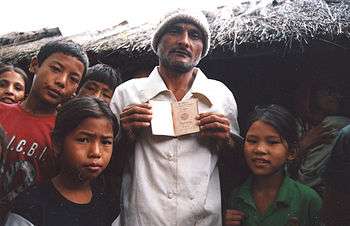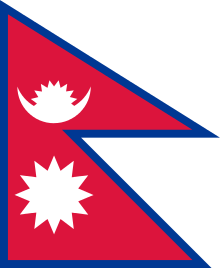Lhotshampa
 Lhotshampa refugees in Beldangi Camp in Nepal. | |
| Total population | |
|---|---|
| (241,899 [2] Many Lhotshampa claim to have been forcibly evicted by the military, who forced them to sign "Voluntary Migration Form" documents stating they had left willingly.[3]:39[4][5]) | |
| Regions with significant populations | |
| United States · Nepal · Thimphu · Paro · Phuntsholing | |
| Languages | |
| Nepali · Dzongkha | |
| Religion | |
| Hinduism · Buddhism | |
| Related ethnic groups | |
| Nepali [6] |
The Lhotshampa or Lhotsampa (Nepali: ल्होत्साम्पा; Tibetan: ལྷོ་མཚམས་པ་, Wylie: lho-mtshams-pa ) people are a heterogeneous Bhutanese people of Nepalese descent. The Lhotshampa people are native to southern Bhutan, and are thus colloquially referred to as Southerners. Starting in 2007, most of the Lhotshampas, or Bhutanese Refugees, were resettled to third countries, such as the United States, Canada, Australia, the United Kingdom, and other European countries. Today, the number of Lhotshampa in Nepal are significantly lower than that in United States, and other countries where they were resettled.[7] Since then, Bhutanese people of Nepalese origin started to settle in uninhabited areas of southern Bhutan.[8]
History
The first small groups of Nepalese emigrated primarily from eastern Nepal under Indian auspices in the late nineteenth and early twentieth centuries.[1][9] The beginning of Nepalese immigration largely coincided with Bhutan's political development: in 1885, Druk Gyalpo Ugyen Wangchuck consolidated power after a period of civil unrest and cultivated closer ties with the British in India.[9] In 1910, the government of Bhutan signed a treaty with the British in India, granting them control over Bhutan's foreign relations.[9][10] Immigrants from Nepal and India continued to enter Bhutan with a spurt from the 1960s when Bhutan's first modern 5-year plan began, many arriving as construction workers. By the late 1980s, the Bhutanese government estimated 28 percent of the Bhutanese population were of Nepalese origin.[1] Unofficial estimates of the ethnic Nepalese population ran as high as 30 to 40 percent, constituting a majority in the south.[1] The number of legal permanent Nepalese residents in the late 1980s may have been as few as 15 percent of the total population.[1]
The government traditionally attempted to limit immigration and restrict residence and employment of Nepalese to the southern region.[1] Liberalization measures in the 1970s and 1980s encouraged intermarriage and provided increasing opportunities for public service.[1] The government allowed more internal migration by Nepalese seeking better education and business opportunities.[1] However, the most divisive issue in Bhutan in the 1980s and early 1990s was the accommodation of the Nepalese Hindu minority.[1]
In 1988, the government census led to the branding of many ethnic Nepalis as illegal immigrants.[9] Local Lhotshampa leaders responded with anti-government rallies demanding citizenship and attacks against government institutions.[9]
In 1989, the Bhutanese government enacted reforms that directly impacted the Lhotshampa. First, it elevated the status of the national dress code of the Driglam namzha from recommended to mandatory. All citizens including the Lhotshampa were required to observe the dress code in public during business hours. This decree was resented by the Lhotshampa who voiced complaints about being forced to wear the clothing of the Ngalong majority.[11][12] Second, the government removed Nepali as a language of instruction in schools, in favor of Dzongkha, the national language.[10] This alienated the Lhotshampa, many of whom knew no Dzongkha at all.
Expulsion
Since the late 1980s, over 100,000 Lhotshampa have been forced out of Bhutan, accused by the government of being illegal aliens. Between 1988-1993, thousands of others left alleging ethnic and political repression.[9] In 1990, violent ethnic unrest and anti-government protests in southern Bhutan pressing for greater democracy and respect for minority rights.[10] That year, the Bhutan Peoples' Party, whose members are mostly Lhotshampa, began a campaign of violence against the Bhutanese government.[10] In the wake of this unrest, thousands fled Bhutan. Many of them have either entered Nepal's seven refugee camps (on 20 January 2010, 85,544 refugees resided in the camps[9]) or are working in India. According to U.S. State Department estimates in 2008, about 35% of the population of Bhutan is Lhotshampa if the displaced refugees are counted as citizens.[13]
Culture
Traditionally, the Lhotshampa have been involved mostly in sedentary agriculture, although some have cleared forest cover and conducted tsheri and slash and burn agriculture.[1] The Lhotshampa are generally classified as Hindus. However, this is an oversimplification as many groups that include Tamang and the Gurung are largely Buddhist;[6] the Kiranti groups that include the Rai and Limbu are largely animist followers of Mundhum (these latter groups are mainly found in eastern Bhutan). Whether they are Hindu or Tibetan Buddhist, most of them abstain from beef, notably those belonging to the orthodox classes who are vegetarians. Their main festivals include Dashain and Tihar, a festival superficially similar to the Indian Diwali.
The oversimplification also carries over into when Lhotshampa immigrated into Bhutan. The government had accepted all those citizens of Nepalese origin who were there prior to 1958. However, settlers continued to enter Bhutan with a spurt from the 1960s when Bhutan's first modern five-year plan began. These numbers swelled significantly and later led to a crackdown by the government.
Language
Main article: Nepali language

Lhotshampas speak Nepali as their first language. Samchi, Chirang and Geylegphug are southern dzongkhags that have a large Lhotshampa community where most people speak Nepali. In southern Bhutan, Nepali used to be taught in the school and was spoken and written in these areas. However, it changed during the 1980s when there was racial conflict between Nepali in Bhutan and Bhutanese. Since then, Nepali is only taught in the home and has become a spoken language in Bhutan. Thus, some Nepali speakers from southern Bhutan can not read or write in Nepali. Currently, Nepali is the first language for most of southern Bhutanese and most people use it in their home. Also, Nepali is most commonly used in school outside of the classes.
Nepali in Bhutan is different in the rural areas and Thimphu. Also, some Nepali words are used differently in Bhutan than Nepali in Nepal.
Vocabulary differences
Nepali words in Bhutan and Nepal
| English | Nepali in Bhutan | Nepali in Nepal |
|---|---|---|
| Brother | Dada | Dai/Dada |
| Dirty | Maila | Phor/Maila |
| Door | Dailo | Dhoka/Dailo |
| Pea | Matar | Kerau/Matar |
| Shop | Dokan | pasal/Dokan |
| Throw | Phag | Phal/phyak |
| Vegetable | Sabji | Tarkari/sabji |
| Vehicle | Gari | Motor/Gadi |
| Wait | Parkhe | parkhe/Parkha |
| Window | Khirkey | jhyal |
See also
- Tek Nath Rizal
- Goldhap Refugee Camp
- Beldangi refugee camps
- Immigration in Bhutan
- Demographics of Bhutan
- Ethnic groups in Bhutan
References
- 1 2 3 4 5 6 7 8 9 10
 This article incorporates public domain material from the Library of Congress document: Worden, Robert L. (1991). Savada, Andrea Matles, ed. "Bhutan: A country study". Federal Research Division. Bhutan - Ethnic Groups.
This article incorporates public domain material from the Library of Congress document: Worden, Robert L. (1991). Savada, Andrea Matles, ed. "Bhutan: A country study". Federal Research Division. Bhutan - Ethnic Groups. - ↑ "Population of Lhotshampas in Bhutan". UNHCR. 2004. Retrieved 2016-03-23.
- ↑ Adelman, Howard (2008). Protracted Displacement in Asia: No Place to Call Home. Ashgate Publishing. ISBN 0-7546-7238-7.
- ↑ Frelick, Bill (2008-02-01). "Bhutan's Ethnic Cleansing". New Statesman, Human Rights Watch. Retrieved 2010-10-03.
- ↑ Mishra, Vidhyapati (June 28, 2013). "Bhutan Is No Shangri-La". The New York Times. Retrieved September 2, 2014.
- 1 2 Repucci, Sarah; Walker, Christopher (2005). Countries at the Crossroads: A Survey of Democratic Governance. Rowman & Littlefield. p. 92. ISBN 0-7425-4972-0.
- ↑ Aris, Michael (1979). Bhutan: The Early History of a Himalayan Kingdom. Aris & Phillips. p. 344. ISBN 978-0-85668-199-8.
- ↑ "Background and History: Settlement of the Southern Bhutanese". Bhutanese Refugees: The Story of a Forgotten People. Archived from the original on 10 October 2010. Retrieved 2010-10-03.
- 1 2 3 4 5 6 7 "Background Note: Bhutan". U.S. Department of State. 2010-02-02. Retrieved 2010-10-02.
- 1 2 3 4 "Timeline: Bhutan". BBC News online. 2010-05-05. Retrieved 2010-10-01.
- ↑ "Country profile – Bhutan: a land frozen in time". BBC News online. 1998-02-09. Retrieved 2010-10-01.
- ↑ "Bhutan country profile". BBC News online. 2010-05-05. Retrieved 2010-10-01.
- ↑ "Bhutan (10/08)". U.S. Department of State. Retrieved 2016-03-14.
External links
- Bhutanese Refugees – A story of a forgotten people
- The Bhutanese refugees
- The Bhutanese Refugees – Human Rights Watch: Bhutanese refugees in Nepal
- UNHCR briefing – Bhutanese Refugees:
- New wave from Bhutan settles in - Burlington (Vermont) Free Press
